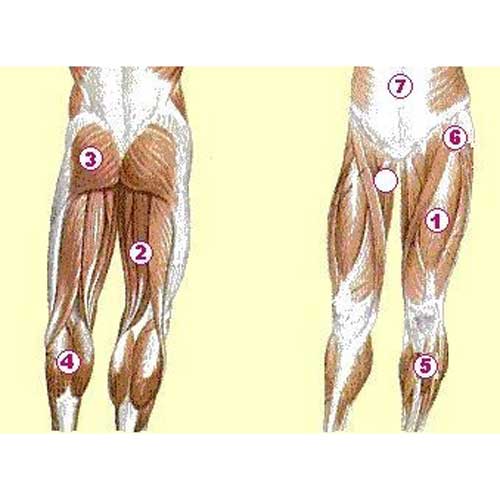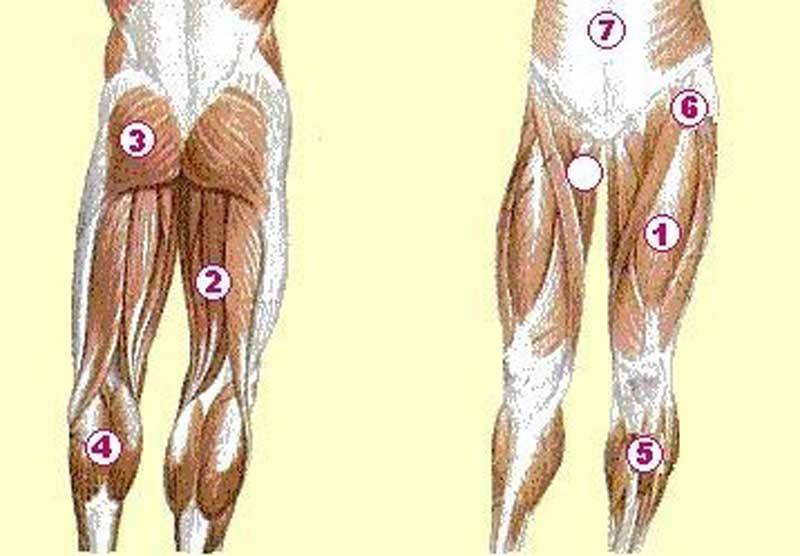
Round step
T r etkoordination – stepping motor exercises
| G total duration
In intensity range |
approx. 45 ‘
GA1 G / GA2 |
|
|
Program: drive in |
10´ |
110 rpm |
|
one-legged right / left (not stepping leg on podium) |
2´ (1´ each) |
50-60 rpm |
|
loosen |
2´ |
110 rpm |
|
full concentration on phase 1 – pressure phase full concentration on phase 2 – pulling phase full concentration on phase 3 – lifting phase full concentration on phase 4 – pushing phase |
1 1 1 1 |
50-60 rpm 50-60 rpm 50-60 rpm 50-60 rpm |
|
loosen |
2´ |
110 rpm |
Concentration 10 revolutions each from phase 1 – 4 in revs – approx. 2’100 rev / min
Conc. 10 revolutions each from phase 4 – 1 against Uzs – approx. 2’100 rpm
| loosen | 1 | 110 rpm |
|
one-legged right / left (not stepping leg on podium) |
2´ (1´ each) |
50-60 rpm |
|
loosen |
3´ |
110 rpm |
|
Loosen the maximum cadence Maximum cadence |
30´´ 1 30´´ |
100 rpm |
|
loosen |
1 |
100 rpm |
|
one-legged right / left (not stepping leg on podium) |
2´ (1´ each) |
50-60 rpm |
|
Extend |
10´ |
100 rpm |
R. a drive – a smooth step
This means relaxed, easy and fluid (and by no means jerky, irregular or stomping) pedaling or stepping. The goal is to achieve the most harmonious and calm movement possible (a calm upper body posture is part of it). The more evenly the force is applied to the pedal, the rounder the step.
D. i e most important muscles for the pedaling movement

1 thigh extensor, 2 thigh flexors, 3 gluteus muscles, 4 calf muscles,
5 shin muscles, 6 Hip flexors, 7 abdominal muscles;
D. i e individual phases of the pedaling movement
Different muscles are used depending on the angular position of the crank. One of the best exercises to become more aware of the individual phases of the kick and the muscles and weak points that are stressed Cycling with one leg . Flat route, medium to large gear and then drive with one leg (first right, then left or vice versa). In this way one notices relatively quickly where the step is irregular and “angular”. The prerequisite for this exercise is that the shoe is firmly connected to the pedals. If a role is available, one-legged riding on the role is also very suitable. Cycling with one leg – good technique training. Below are the individual phases of the pedaling movement and the muscles that are mainly used.

The step technique is most effective when the force is applied exactly at a right angle (90 degrees) to the crank position (the arrows in the illustration).
Sector 1 – push phase: Mainly used muscle: thigh extensor.
Sector 2 – printing phase: Mainly used muscles: hamstrings, glutes.
Sector 3 – pull phase: Mainly used muscle: hamstring flexors.
Sector 4 – lifting phase: Mainly used muscles: hip flexors, book muscles.
The calf muscles stretch the ankle and are particularly active in sectors 2 and 3. The shin muscle causes the ankle to flex and is mainly active in sector 1 and (minimally) in sector 4.
The individual phases are shown again below. Pay attention to the foot movement (flexion and extension of the ankle, which is caused by the calf and shin muscles) and the angular position of the foot.
Different muscles are used in the individual phases of the kick. The largest
Force is of course developed when the pedals are depressed (sector 2 – pressure phase). In this phase, the thigh extensors (the muscles on the front of the thigh) and the gluteal muscles (plus the calf) work primarily. If the pedal is in the lowest position (sector 2 – pulling phase), the thigh flexor (the muscle on the back of the thigh) is mainly working, the pedal is “pulled” backwards. In practice, hardly anyone can pull up the pedal in sector 3 (lifting phase) in the long term (and if so, the influence on the propulsion of the bike is only minimal), even if it is often stated / written that this “pulling up” is the decisive factor on the round step.
Nevertheless, I think the practice of pulling the leg up is useful and helpful. If you do not lift your leg at all, you are even working against your other leg, which is pushing down, which additionally has to overcome the weight of the “not pulled up” leg. And individual drivers actually manage to generate propulsion during the lifting phase (see also the PDF file “The round step – myth or reality?” At the end of this page). In the area of the highest position of the pedal (sector)
1 – push phase), the thigh extensor is particularly active, the pedal is pushed forward.
If you look at the size of the propulsion generated in the individual sectors, the picture looks something like this:
Sector 1 – push phase: 10% Sector 2 – push phase: 70% Sector 3 – pull phase: 20% Sector 4 – lift phase: 0%
Quite far from the theoretical ideal of 25% – 25% – 25% – 25% (which is really only theoretical – in practice, the muscles that work when pushing down are of course much stronger than those that are involved in “pulling up”) . One can become a master in this “discipline”. For example, those who have fully mastered the individual phases and are fully aware of their muscles can only use the thigh flexor (the muscle at the back of the thigh). That means: practically the entire propulsion on the bike is generated with this muscle. This naturally leads to the fact that this muscle tires relatively quickly, while the other muscles are hardly used. If the thigh flexor is “tired”, you simply change the muscle and generate the propulsion for a while, for example, only with the thigh extensor (the muscle on the front of the thigh).
In the next phase you only drive with the gluteal muscle and a little later practically only with the Hip flexors and the abdominal muscles (by pulling up the pedals; i.e. the muscles which, for example, during the exercise Trunks are mainly claimed). In the same way, you can even use the calf and shin muscles in a fairly (completely) isolated manner.
When you press the pedals down (which is associated with an extension of the ankle), you only work with your calves as much as possible until the end of the pulling phase (sector 3). In the other exercise, when pulling up (which involves flexing the ankle), you only work with the shin muscle (the muscle on the front of the lower leg) as much as possible. A master in this discipline can exercise each of the muscles mentioned more or less in isolation at any time and specifically tire or relieve them.
Driving in small gears is also beneficial for a round step. 100 revolutions per minute on the flat (a little less on the mountain) should be the rule. This promotes efficiency. Frequent training with too “thick” gears, on the other hand, leads to the opposite. Anyone who “hops” in the saddle at high cadence (over 110 revolutions per minute) can still step up. The idea that your own legs are an electric motor, which gently and evenly distributes the power to the pedals and the chainring, or the idea that your foot brushes the inner wall of a lying bin can also be helpful.
Another advantage (and stylistically more beautiful) is a calm upper body posture when riding in the saddle (figuratively: the upper body is clamped in a vice and the legs work like high-precision piston machines – the bike itself does not pivot to the right or left, all the energy is used for propulsion implemented).
Leave a comment